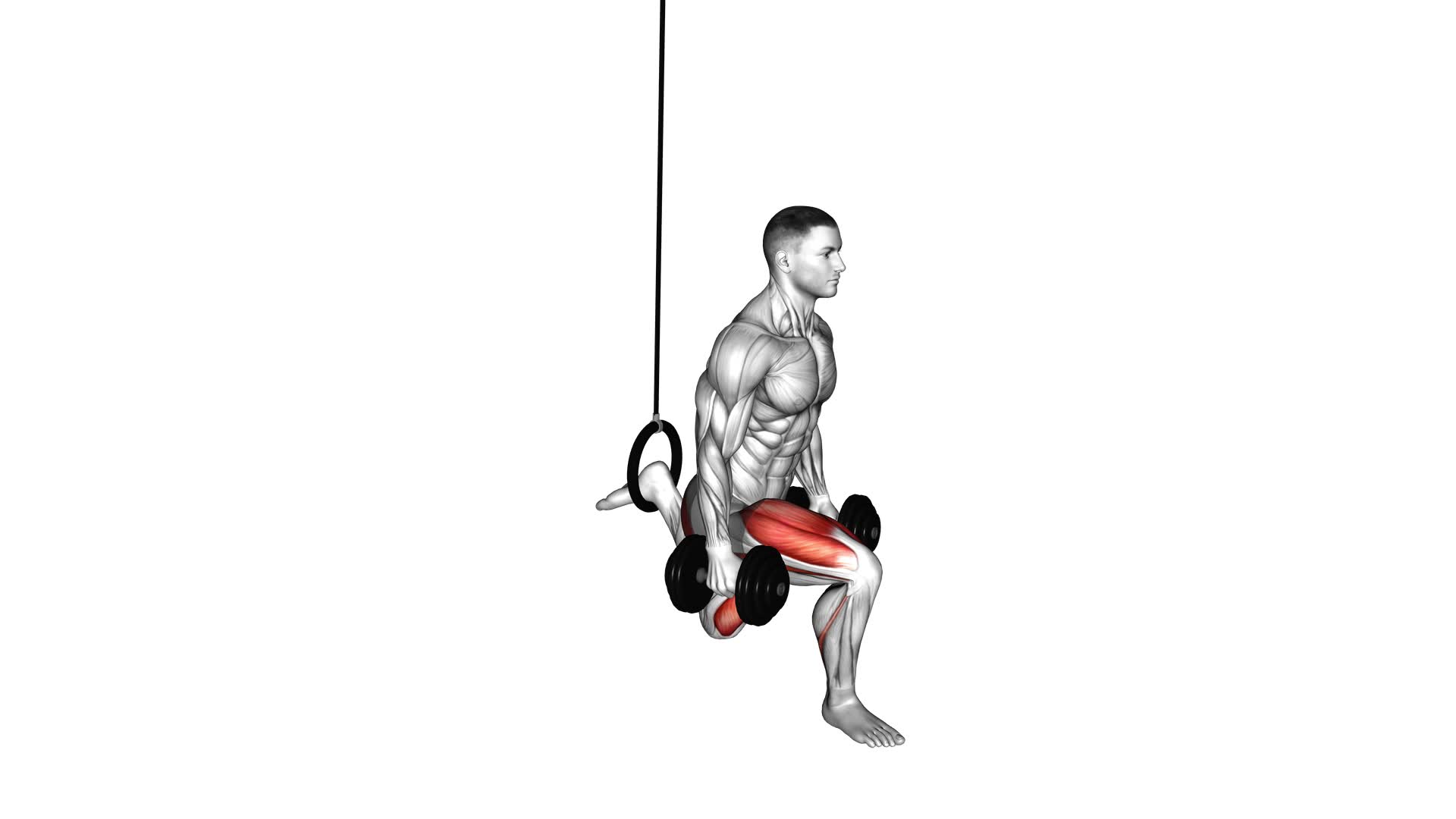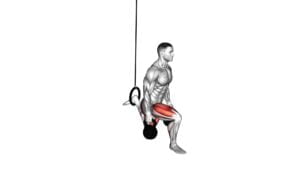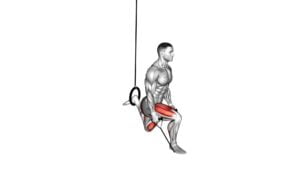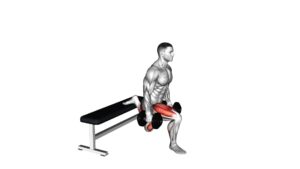Dumbbell Single Leg Split Squat With the Ring – Video Exercise Guide & Tips

Are you looking for a challenging leg exercise that targets multiple muscle groups? Look no further than the Dumbbell Single Leg Split Squat with the Ring.
Watch This Exercise Video
This exercise not only strengthens your legs and glutes but also improves balance and stability.
In this video exercise guide, we will show you the proper form and technique to perform this exercise effectively.
Get ready to take your leg workout to the next level with this intense exercise.
Key Takeaways
- Engages in unilateral training, correcting muscle imbalances
- Improves overall strength and coordination
- Increases stability and balance
- Strengthens muscles in the ankles to prevent injuries
Benefits of the Dumbbell Single Leg Split Squat With the Ring
The dumbbell single leg split squat with the ring offers numerous benefits for your lower body strength and stability. One of the main benefits is that it allows you to engage in unilateral training, which means you're working one side of your body at a time. This helps to correct any muscle imbalances that you may have, as well as improve your overall strength and coordination.
By performing the dumbbell single leg split squat with the ring, you're also able to increase your stability and balance. This exercise requires you to balance on one leg while performing the squat, which challenges your core muscles and improves your balance. It also helps to strengthen the muscles in your ankles, which can help prevent injuries.
To maximize the benefits of this exercise, it's important to focus on maintaining proper form throughout. Keep your chest up, shoulders back, and core engaged. Make sure to lower your body down until your thigh is parallel to the ground, and then push through your heel to return to the starting position.
Incorporating the dumbbell single leg split squat with the ring into your workout routine can greatly improve your lower body strength, stability, and balance. So give it a try and start reaping the benefits today!
Equipment Needed for the Dumbbell Single Leg Split Squat With the Ring
To perform the Dumbbell Single Leg Split Squat With the Ring, you'll need a set of dumbbells and a ring.
Make sure to choose dumbbells that challenge your muscles without compromising your form.
The ring will provide stability and support during the exercise, helping you maintain proper balance and alignment.
Required Equipment for Exercise
You will need one dumbbell and a fitness ring for the Dumbbell Single Leg Split Squat With the Ring exercise.
The fitness ring is a versatile piece of equipment that can add an extra challenge to your workout. It helps improve stability, balance, and core strength.
By incorporating the ring into the exercise, you engage your muscles in different ways, making the workout more effective.
If you're new to using the fitness ring, start with a lighter dumbbell and focus on maintaining proper form. As you become more comfortable, you can increase the weight and intensity of the exercise.
To modify the exercise, you can use a lower weight dumbbell or perform the split squat without the ring.
To progress, you can use a heavier weight dumbbell or try adding a plyometric jump at the end of each rep.
Remember to always listen to your body and adjust the exercise accordingly.
Proper Form and Technique
Maintain stability and engage your core by properly using the fitness ring and dumbbell in the Dumbbell Single Leg Split Squat With the Ring exercise.
Start by holding the fitness ring in front of your chest with both hands, ensuring a firm grip. Stand with one foot in front and the other foot positioned behind you. Keep your chest up and your shoulders back throughout the exercise.
As you descend into the squat, make sure your front knee stays in line with your toes and your back knee hovers just above the floor. Push through your front heel to return to the starting position.
To modify this exercise, you can perform it without weights or use a lower weight dumbbell. To progress, you can increase the weight of the dumbbell or add more repetitions. Mastering proper form and technique will maximize the benefits of this exercise.
Now, let's move on to the next section to learn about the benefits of using rings.
Benefits of Using Rings
Using rings in the Dumbbell Single Leg Split Squat With the Ring exercise offers various benefits for your stability, strength, and overall fitness. One of the advantages of using rings is that they challenge your stability muscles more than traditional dumbbells or barbells. The instability created by the rings forces your muscles to work harder to maintain balance, resulting in improved core strength and overall stability.
Additionally, using rings allows for a greater range of motion in the exercise, targeting different muscle fibers and enhancing muscle development. However, there are also some disadvantages to using rings. They require a certain level of coordination and strength to use properly, and if not used correctly, they can increase the risk of injury.
It's important to start with lighter weights and focus on maintaining good form when using rings to minimize the risk of injury.
Proper Form and Technique for the Dumbbell Single Leg Split Squat With the Ring
To perform the Dumbbell Single Leg Split Squat With the Ring correctly, start by ensuring proper foot placement. Keep your front foot flat on the ground, with your knee directly above your ankle, and your back foot elevated on the ring. Avoid the common mistake of letting your front knee extend past your toes.
This exercise offers numerous benefits, such as increased lower body strength and stability, and can be modified by adjusting the weight or using different variations like the Bulgarian split squat.
Foot Placement Tips
Your foot placement plays a crucial role in maintaining proper form and technique for the Dumbbell Single Leg Split Squat With the Ring.
To ensure proper foot placement, start by standing with your feet hip-width apart. Take a step forward with one foot and position it so that your knee is directly above your ankle when you lower into the squat.
Your back foot should be positioned on the toes, with the heel slightly lifted off the ground. This will create a stable base and allow for proper alignment and balance throughout the exercise.
Experiment with different foot placement techniques, variations, and progressions to find what works best for you.
Now, let's move on to the next section and learn about common mistakes to avoid.
Common Mistakes to Avoid
When performing the Dumbbell Single Leg Split Squat With the Ring, it's important to avoid common mistakes that can hinder proper form and technique.
One common mistake is improper foot placement. Make sure your front foot is far enough forward so that when you lower your body, your knee is directly above your ankle. Your back foot should be positioned so that your heel is lifted off the ground.
Another mistake to avoid isn't using modifications and progressions. If you're a beginner, start by performing the exercise without weights or using a lower weight dumbbell. As you become more comfortable and stronger, you can gradually increase the weight or try more challenging variations.
Benefits and Variations
Maximize your workout with the benefits and variations of the Dumbbell Single Leg Split Squat With the Ring.
This exercise not only targets your quads, hamstrings, and glutes but also improves your balance and stability.
To add variety to your routine, you can try different variations of this exercise.
One variation is the elevated split squat, where you place your rear foot on a bench or step. This increases the range of motion and challenges your stability even more.
Another advanced technique is to add a twist at the top of the movement, engaging your obliques and core muscles.
You can also increase the intensity by using heavier dumbbells or performing the exercise at a slower tempo.
Experiment with these variations and advanced techniques to keep challenging your muscles and making progress in your fitness journey.
Modifications and Progressions for the Dumbbell Single Leg Split Squat With the Ring
To modify and progress the dumbbell single leg split squat with the ring, you can incorporate different variations and increase the resistance. Here are some modifications and progressions you can try:
- Variation: Elevated Split Squat
To increase the difficulty and target your muscles differently, elevate your back foot on a step or platform. This will require more stability and strength in your front leg.
- Variation: Bulgarian Split Squat
Similar to the elevated split squat, the Bulgarian split squat involves placing your back foot on a bench or box. This increases the range of motion and challenges your muscles even more.
- Progression: Increase the Weight
As you become stronger, gradually increase the weight of the dumbbells. This will help to build more muscle and strength in your legs.
- Progression: Slow and Controlled Movements
Focus on performing the exercise with slow and controlled movements. This will increase the time under tension for your muscles, making the exercise more challenging.
Remember to always maintain proper form and listen to your body. If an exercise feels too difficult or causes pain, modify or regress the movement to ensure safety. As you progress, continue to challenge yourself with different variations and increasing resistance to keep seeing results.
Common Mistakes to Avoid During the Dumbbell Single Leg Split Squat With the Ring
One common mistake to avoid during the dumbbell single leg split squat with the ring is allowing your knee to cave inwards. This can put unnecessary strain on your knee joint and increase the risk of injury. To prevent this, make sure to keep your knee in line with your toes throughout the entire movement.
Another common mistake is improper foot placement. Your front foot should be planted firmly on the ground, with your heel and toes in contact with the floor. Your back foot should be elevated on the ring, with your toes pointing downwards. This will help maintain stability and balance throughout the exercise.
It is also important to note that modifications and progressions can be made to suit your fitness level. If you're a beginner, you can start by performing the exercise without any weights or using a lower weight. As you become more comfortable and stronger, you can gradually increase the weight or add more challenging variations, such as holding the dumbbells at your sides or performing the exercise on an unstable surface.
Remember to always listen to your body and adjust the intensity according to your capabilities. By avoiding these common mistakes and following proper foot placement tips, you can maximize the effectiveness of the dumbbell single leg split squat with the ring while minimizing the risk of injury.
Tips for Incorporating the Dumbbell Single Leg Split Squat With the Ring Into Your Leg Workout Routine
To incorporate the dumbbell single leg split squat with the ring into your leg workout routine, focus on maintaining proper form and gradually increasing the intensity as you become stronger.
Using rings in your leg workouts can provide various benefits. They challenge your stability and balance, engage your core muscles, and target different muscle groups in your legs.
To start, position the ring at hip height and stand facing away from it. Hold a dumbbell in each hand, with your arms by your sides. Place the top of your foot on the ring, and step forward with your other foot, creating a split stance. Lower your back knee towards the ground, while keeping your front knee directly above your ankle. Make sure to keep your torso upright and engage your core throughout the movement.
As you become more comfortable, you can increase the challenge by performing the split squat with a deficit or by adding more weight. Remember to listen to your body and progress at your own pace.
Frequently Asked Questions
How Many Sets and Reps Should I Do for the Dumbbell Single Leg Split Squat With the Ring?
For the dumbbell single leg split squat with the ring, it's important to determine the right number of sets and reps to maximize your workout. Start with 3 sets of 10 reps on each leg and gradually increase as you get stronger.
Remember to focus on proper form and control throughout the exercise.
If you want to switch things up, you can try different variations of the dumbbell single leg split squat to challenge your muscles in new ways.
Can I Use a Resistance Band Instead of a Ring for This Exercise?
Yes, you can use a resistance band instead of a ring for this exercise.
However, using a ring offers certain benefits. The ring provides stability and support, which can help improve your balance and target your muscles more effectively.
Additionally, the ring allows for a wider range of motion, allowing you to achieve a deeper squat.
Is It Normal to Feel a Burning Sensation in My Quadriceps During the Dumbbell Single Leg Split Squat With the Ring?
Feeling a burning sensation in your quadriceps during the dumbbell single leg split squat with the ring is normal. It means your muscles are working hard.
However, if you have knee or ankle issues, it's important to modify the exercise or consult a professional for alternative options.
Remember to listen to your body and make adjustments as needed to avoid any unnecessary discomfort or injury.
How Often Should I Include the Dumbbell Single Leg Split Squat With the Ring in My Leg Workout Routine?
To progress in the dumbbell single leg split squat with the ring, you should gradually increase the weight and focus on maintaining proper form.
Incorporating unilateral exercises like this into your leg workout routine has many benefits. It helps improve balance, stability, and muscle imbalances.
Aim to include this exercise at least once or twice a week, alternating with other lower body exercises. Remember to listen to your body and adjust the frequency based on your fitness level and goals.
Can I Do This Exercise if I Have Knee or Ankle Issues?
If you have knee or ankle issues, it's important to consider alternatives for the Dumbbell Single Leg Split Squat with the Ring. This exercise can put strain on those areas, so modifications may be needed.
If you're a beginner, start with easier variations like regular split squats or stationary lunges to build strength and stability.
Always listen to your body and consult a professional if you're unsure about any exercises.
Conclusion
Incorporating the dumbbell single leg split squat with the ring into your leg workout routine can provide numerous benefits. It helps improve balance, stability, and strength in the lower body.
Remember to maintain proper form and technique, and avoid common mistakes such as leaning forward or allowing the knee to go past the toes.
With the right equipment and modifications, you can progress and challenge yourself as you continue to build muscle and improve your overall fitness.

Author
Years ago, the spark of my life’s passion ignited in my mind the moment I stepped into the local gym for the first time. The inaugural bead of perspiration, the initial endeavor, the very first surge of endorphins, and a sense of pride that washed over me post-workout marked the beginning of my deep-seated interest in strength sports, fitness, and sports nutrition. This very curiosity blossomed rapidly into a profound fascination, propelling me to earn a Master’s degree in Physical Education from the Academy of Physical Education in Krakow, followed by a Sports Manager diploma from the Jagiellonian University. My journey of growth led me to gain more specialized qualifications, such as being a certified personal trainer with a focus on sports dietetics, a lifeguard, and an instructor for wellness and corrective gymnastics. Theoretical knowledge paired seamlessly with practical experience, reinforcing my belief that the transformation of individuals under my guidance was also a reflection of my personal growth. This belief holds true even today. Each day, I strive to push the boundaries and explore new realms. These realms gently elevate me to greater heights. The unique combination of passion for my field and the continuous quest for growth fuels my drive to break new ground.







